Dark Star
Symbolism
In previous pages I have outlined a
correlation between certain astrological images used in the study of Alchemy
with the existence of an anomalous planet. My working assumption is that
the roots of alchemy go back to ancient times, and that the creators of that
tradition were aware of Nibiru. That secret knowledge was lost to us
through time, but the symbols of that unseen planet (actually a small brown
dwarf) remain within esoteric traditions.
In these pages I will present several good
examples of the kind of imagery I'm talking about. I will explain why the
explanations used by other researchers fall short of explaining the anomalies,
and how the existence of the Dark Star allows us to move forward in our
understanding of the ancient knowledge.
Some of these images have been obtained from a
wonderful book called "Alchemy and Mysticism: The Hermetic Museum" by Alexander Roob, published by Taschen in 1996. Alongside the pictures I will present
their text and the page reference. After that I will discuss the image in
the light of the Dark Star Theory.
Belarus Crest

Dark Star symbolism can be found
hidden away in unlikely places. Unlikely, perhaps. Because many
of the symbols used by countries and religious organisations seem to have
been derived from early symbols. For instance, this crest of the
former Soviet country of Belarus may just appear to depict bountiful
harvests under the Red star of Communism, but this simple interpretation
belies a more esoteric possibility. A winged disc is used in this
motif. The Red Star, which may be one of many global iconic
interpretations of the symbol of ancient Nibiru, is clearly seen here
lording over its binary companion, the Sun.
Alchemy
Many will be familiar with the all-seeing eye
glaring out from the Masonic pyramid on U.S. currency.
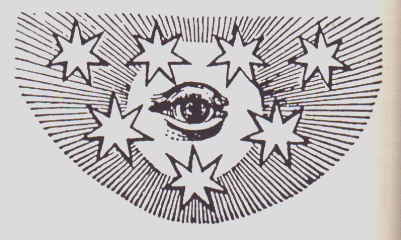
"The divine underground as 'Eternity's eye of
wonder' reveals itself in the mirror of wisdom (Sophia). "It is like
an eye that sees and yet guides nothing in seeing that it may see, for the
seeing is without being (...) Its seeing is in itself"
(J. Bohme, 18th Century - Taschen p242)
Here it is
inexplicably surrounded by seven stars within an 'aurora'. The
eye in the centre represents the planetary disc of the gods, Nibiru, with its
fiery radiance and orbits set of seven moons. I can be certain of this
astronomical connection because this symbol also features on a Masonic apron
worn by George Washington. The apron was given to Washington by Elankah
Watson and is now treasured by Alexandria Lodge 22 (Ovason 2000, pp81-3).
The radiant eye and its seven stars takes
centre stage above the Masonic Temple, with the Sun and Moon to either side.
Because the Sun and Moon are already represented, the seven stars cannot stand
for the seven planets (which include the Sun and Moon). So neither do they
here. The eye symbol probably arises from the connection with the 'gods'
of this Dark Star system, the Nefilim, or 'Watchers'.
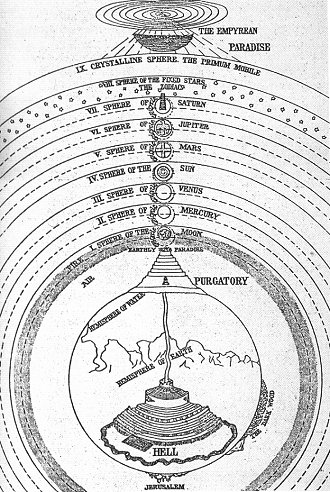
"In Dante's Divine Comedy (1307-1321), the soul
on its pilgrimage rises from the realm of Hell, which projects spherically
into the earth, via the mountain of Purgatory and the nine spheres of the
planets, the fixed stars and the crystalline sphere, all of which are kept
in motion by angels, up to Paradise, where it finds its home in the white
rose of heaven, illuminated by the divine light."
(Michelangelo Cactani, La Materia della Divina
Commedia di Dante Alighieri, 1855 - Taschen p41)
What is of interest here is the position of
Paradise above the celestial spheres. The relative positions of the
spheres of the planets may be outdated now, but one can discern a solar system
of sorts on Dante's work, as it was understood at the time. As his poem
reaches its triumphant climax in 'Paradise' and Dante ascends to the highest
plane to gaze once again upon his beloved Beatrice, we are treated to a bizarre
description of heaven.
"So, as I looked, to
greater joyances
The gems and flowers were changed, and I
beheld
Both courts
of Heaven in true appearances"
(Dante XXX, 94-6)
Both courts of Heaven? Are there
two sources of radiance in Dante's heavenly sky? It would appear so, and Dante
states that the second source of radiance orbits the Sun in a loosely bound
fashion:
"In yonder heaven
the lumen gloriae
Reveals the maker to created mind
Which in His sight alone finds peace for
aye.
"In figure of a circle it doth wind
So wide and far that its circumference
About the sun
itself would loosely bind."
(Dante XXX, 100-5, Translated by Dorothy
Sayers 1962)
Looking at the image above, Dante has
spiritually ascended out of the solar system and has entered a new 'system'
which remains connected to the Sun. This connection is 'loosely bound' in
Dante's words. This is a very bizarre description, even for a poem that is
full of archaic and esoteric references. Dante was versed in plenty of
esoteric wisdom and tradition, and his poem was a double-edged sword for the
Church.
Did Dante know of the Eighth Sphere above the Solar System, the
location of the home of the 'immortal' gods? Standing on their heavenly
world and looking up into the sky one would see two Suns: the immediate and
divine radiance of Nibiru, a sub-brown dwarf that is the planetary centre of their
system, and our Sun. Our Sun would appear to them like a large star at
that distance, around which the Dark Star system winds in its great, loosely
bound orbit.
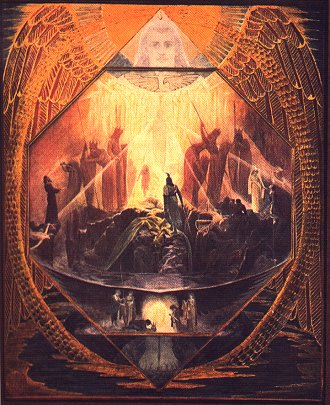
"After the death of Madame Blavatky, there was a
break in 1895 between the Indian headquarters of the Theosophical Society
and its original seat in the USA, which was run by Katherine Tingley.
Christian and Nordic motifs predominate in her painting of the eternal
cycle of global ascents and descents.
When the leaders of the society in India
sought to impose upon its European members a Hindu boy called Krishnamurti
as a new Messiah, in 1913, under the direction Rudolf Steiner, the German
section broke away to form itself as the Anthroposophical Society."
(The Theosophical Path, Ed. Katherine Tingley,
Point Loma, California, USA, 1926 - Taschen p431)
In this painting by Katherine Tingley the
Winged Disc is associated with Christ. The wings of the disc also contain
serpentine features in the form of the Ouroboros; the alchemical dragon that
devours its own tail. I have written about the link between the
Theosophical Society and its beliefs and the existence of the Dark Star before,
particularly with respect to the Eighth Sphere. This wonderful painting
captures the connection between the Winged Disc and Messianic beliefs, a theme
that I developed in my first book. Make what you will of the Nordic
mythological scene in the centre, but there is a strong hint of the Return of
the Lost King.
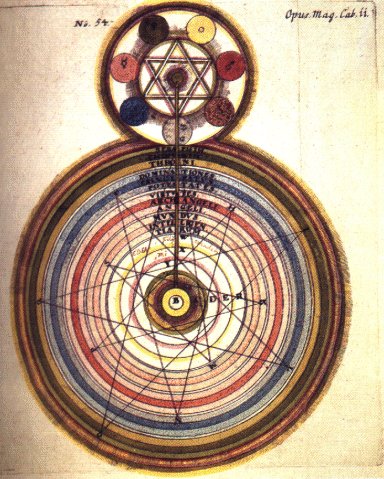
"From the divine throne-world with the "Seven Great
Spirits of Revelation" the divine light pours through Sachariel, the
spirit of Jupiter, creating the spirit world as the archetype of "our
solar system in its most perfect state."
"BCDE is the world of the son of the red dawn
(Lucifer)(...) to which shone all the rays of the light of divine
majesty." The third world consists of the 12 choirs of the angelic
hosts. Through his arrogance, Lucifer causes "the confusion of his
wonderful spirit-world with the earthly one".
(Gregorius Anglus Sallwigt (pseudonym of von
Welling), Opus mago-cabalisticum, Frankfurt, 1719 - Taschen p323)
This is not dissimilar to Dante's scheme
already discussed above, and I suspect that Georg von Welling (1655-1725) based
his drawings upon it. Without wishing to fall into the trap of 'confusing the
spirit-world with the earthly one', if this Sephiroth scheme is indicative of
our solar system, then it is a self-evident binary. The main star is a
large yellow one (the Sun), and the small companion is a dark red one (the Dark
Star). The Dark star is associated with the Star of David, which verifies
its Messianic significance. It is clear that the upper red orb isn't the
Sun because of this connection with the Star of David.
But the confusion in this image lies in the
seven spheres around the Dark Star. Each is given a sigil of a planet,
while 'the sun' is surrounded by the spiritual layers of the angelic hosts.
Although this symbolises the duality of spirit and matter, I think that von
Welling has simply corrupted the vision of Dante. He has mixed up the
seven 'stars' associated with the Dark Star with the seven planets of the
alchemists and astrologers. Nevertheless, the binary solar system's
character is superbly represented in this image.
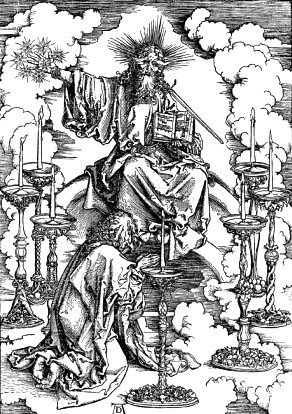
Albrecht Dürer:
St. John and the angel with the seven stars
Woodcut, 39 x 28 cm, 1496-98
This is a fascinating image, from a 15th
Century woodcut. The central character is presumably God, or
an arch-angel, sat upon a throne in the heavens. His
head radiates light, whilst his right hand holds seven stars.
This latter symbolism is repeated with the seven candles surrounding
this angel and the worshipping adept.
The adept is possibly St John, giving this image a feeling of the
Apocalypse of St John in Revelations. What strikes me
particularly about this is the clear Dark Star symbolism pertaining
to the central figure. What other astronomical phenomenon is
associated with a central light source with 7 attendant stars?
There is a lot of Alchemy within this woodcut.
Written by Andy Lloyd, 1st
October 2003 - 9th October 2005, with thanks to Martin Cosnette
author of 'The Dark Star'
(2005), 'Ezekiel One'
(2009), 'The Followers of
Horus' (2010) and 'Darker Stars' (2019)
Go to Dark Star Alchemy
2











